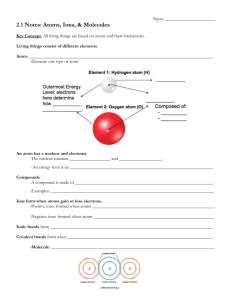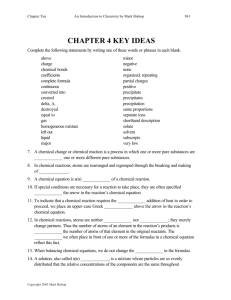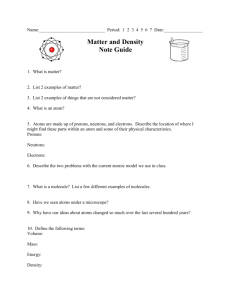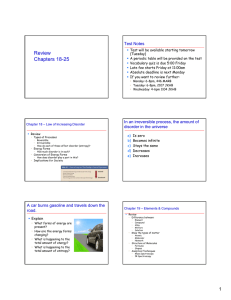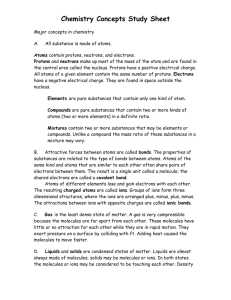Click here for review
advertisement
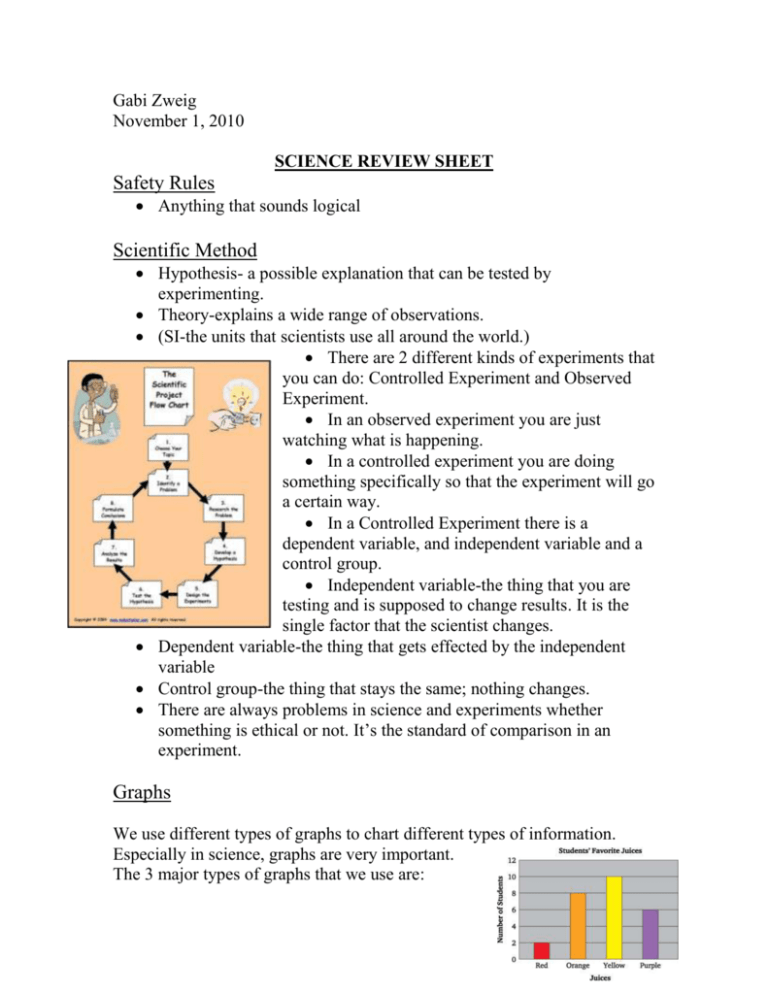
Gabi Zweig November 1, 2010 SCIENCE REVIEW SHEET Safety Rules Anything that sounds logical Scientific Method Hypothesis- a possible explanation that can be tested by experimenting. Theory-explains a wide range of observations. (SI-the units that scientists use all around the world.) There are 2 different kinds of experiments that you can do: Controlled Experiment and Observed Experiment. In an observed experiment you are just watching what is happening. In a controlled experiment you are doing something specifically so that the experiment will go a certain way. In a Controlled Experiment there is a dependent variable, and independent variable and a control group. Independent variable-the thing that you are testing and is supposed to change results. It is the single factor that the scientist changes. Dependent variable-the thing that gets effected by the independent variable Control group-the thing that stays the same; nothing changes. There are always problems in science and experiments whether something is ethical or not. It’s the standard of comparison in an experiment. Graphs We use different types of graphs to chart different types of information. Especially in science, graphs are very important. The 3 major types of graphs that we use are: Bar Graph Line Graph Pie Chart Properties of Life 1. Cellular Organization 2. Homeostasis-the maintenance of stable internal conditions in spite of changes in the external environment 3. Metabolism-the sum of all the chemical reactions carried out in an organism. 4. Responsiveness-living organisms respond to their external environment. 5. Reproduction-the process by which organisms make more of their own kind from one generation to the next. 6. Growth 7. Heredity-when an organism reproduces, it passes on its own traits to its offspring in a process Diseases Epidemiology-the study of how diseases spread. Genome- the complete set of genetic information for an organism. Ways to prevent the spread of disease: 1. Vaccination-a medical procedure that allows a person to resist infection by a disease. 2. Quarantine-being isolated 3. Antibiotics-medicine that you can take to get better. Assistive Technology: Artificial prosthetics (limbs) 1. 2. 3. 4. Battlefield Medicine: Blood clotting Bandaging Remote Surgery Robot Surgery Genetic Engineering- a technology in which the genetic material of a living cell is changed. An example of Genetic Engineering: If DNA were modified to kill of the pest so there would be less pest eating our food. Biological Research Biotechnology-the application of knowledge of biology to improve the lives of humans. Biomimetics-the kind of technology that produced Velcro. It’s the application of biological processes and systems to solve design and engineering problems. Mimicking and imitating things. Ex: sap, submarines (fish), airplane (birds), parachute (squirrel), jungle gym (spider web), tree house (birds’ nest) Biometrics-things to determine someone’s identity. Ex: fingerprints, iris scan, DNA, retnal (part of your eye) scan, teeth Imaging System CAT SCAN-x-rays-3D ... this kind of scan is better for the bones MRI- magnetic resonance. This can be used for seeing everything. They are more expensive. Atoms Atom- the smallest unit of matter that can’t be broken down by chemical means Atoms are made out of 3 things: protons, neutrons, and electrons Protons-positive charge Neutron-no charge Electron-negative charge Element-a substance made up of atoms that have the same # of protons Isotopes-atoms that have a different number of neutrons There are (more than) 3 levels in the electron cloud. The first level can hold 2 electrons, the second level can hold 8 and the third level can also hold 8 Valence electrons-electrons in the outer most shell Compound-a substance made of the bonded atoms of two or more different elements There are 3 different kinds of bonds: covalent, ionic, hydrogen Covalent bond-a way that atoms bond is by sharing valence electrons Ionic bond-the attractive force between oppositely charge ions Hydrogen bond-attracts the negative pole of other nearby molecules. When it is bonded to an oxygen, nitrogen, or fluorine atom, hydrogen atoms have a partial charge nearly as great as a proton’s charge Atomic #-the # of protons and electrons Atomic Mass- the # of protons and neutrons. Ion- an atom or group of atoms that has an electric charge because it has gained or lost electrons. Polar-it has positive and negative ends. There are some charges on each end. Non-polar-there are no charges Solution-a mixture in which 2 substances are uniformly distributed Solute-substance that dissolves in solution Solvent-substance in which solute is dissolved Suspension-a mixture of water and small non-dissolved non-polar molecules. EX: Water is polar therefore non-polar molecules do not dissolve in water, but polar and ionic do dissolve in water. Na+ (sodium) is an example of a positive ion. Cl- (chlorine) is an example of a negative ion. NaCl (sodium-chloride) is an example of an ionic compound. O2 (oxygen) is an example of a (non-polar) molecule. H2O (water) is an example of a polar (or compound) molecule. Properties of Water Ice floats- water becomes less dense as a solid than as a liquid because when water freezes, hydrogen bonds lock water molecules into a crystal structure that has empty spaces. Water absorbs and retains heat Water molecules stick to each other Water molecules stick to other polar substances Cohesion-the attraction of particles of the same substance Adhesion-the attraction of particles of different substances Solutions Solution- a mixture in which ions or molecules of one or more substances are evenly distributed in another substance. Acids-compounds that form extra hydronium ions when dissolved in water. Bases-compounds that form extra hydroxide ions when dissolved in water. pH Scale Numbers from 1-7 are acidic. Numbers from 8-14 are basic. Number 7 is neutral. The lower the number is on the acidic level, the more acidic it is. The higher the number on the basic level, the more basic it is. To neutralize an acid you would add a base and to neutralize a base you would add an acid.





